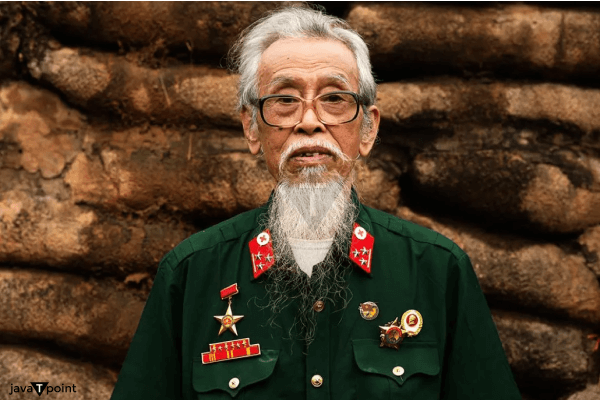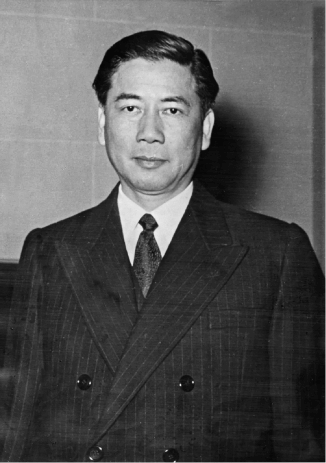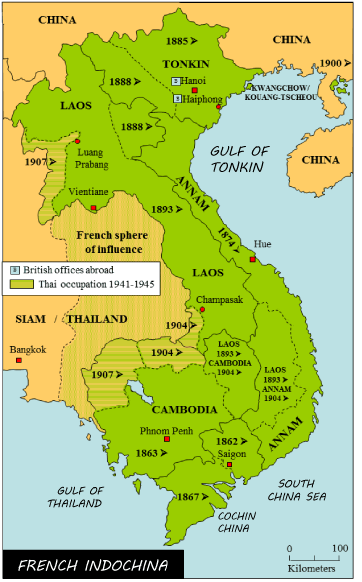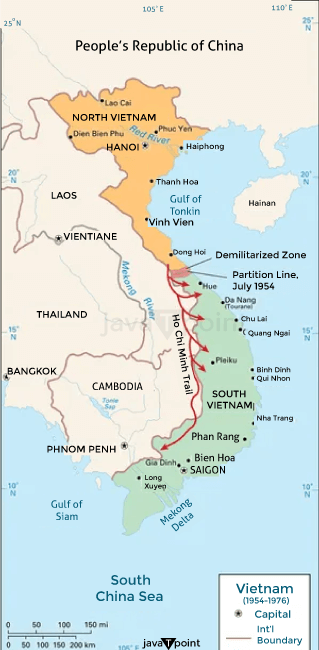Vietnam War SummaryIntroductionThe Vietnam War, also known as Second Indo-China War, held during the period from 1954 to 1975, was a long, destructive, and divisional clash that included South Vietnam, which was supported by the United States, and the Communist Government of North Vietnam. At the time period of the Vietnam War, Cold War was also going on in the World, so due to Cold War, the Vietnam War intensified because the United States was supporting South Vietnam and North Vietnam was neutral (not supporting any superpower in Cold War). In this War, more than thirty lacks (30 lacks) people died, of which fifty-eight thousand (58,000) were Americans, and more than fifteen lacks (15 Lakh) were Vietnam Civilians casualties. This war ended when South Vietnam (supported by the United States) got merged with the Communist Party of North Vietnam in 1975, and the name after the merger was the Social Republic of Vietnam. Information About Cold WarCold War was a preventive and restricted rivalry between the United States and the Soviet Union and the countries which are allies of respective groups; this rivalry evolved right after the Second World War. This geopolitical tension between the Eastern European Countries, i.e., the Soviet Union, and the Western European Countries, i.e., the United States, held during the time span from 1945 to 1991; during this time, the world got divided into two powerful groups ruled by two superpowers of the world the Soviet Union and the United States. Origin of the Vietnam WarVietnam is a country, which is located in Southeast Asia at the corner of the Indochinese peninsula, which has been under the control or colonial rule of France since the nineteenth century (19th Century). During the period of Second World War, the League of the Independence of Vietnam (also known as Viet Minh) was formed to fight back against the attack of the Japanese military and also for the independence of Vietnam from the colonial rule of France; this group (Viet Minh) was formed by Ho Chi Minh. (Political leader; Ho Chi Minh was influenced by Chinese and Soviet Communism). After the defeat of Japan in the Second World War in 1945, Japan ordered his military forces to fall back from Vietnam; which left Emperor Bao Dai, who got educated in France and came to rule Vietnam afterward, the ruler of Vietnam. As the Viet Minh or the League of the Independence of Vietnam was in search of an opportunity to take control, they immediately took action and took control over the northern city of Hanoi and claimed the city as the Democratic Republic of Vietnam (DRV), which was also known as North Vietnam and declared Ho Chi Minh as their President. But Emperor Bao Dai, whom France supported, wanted to take back that region of Vietnam and set up the state of Vietnam, which was also known as South Vietnam, in 1949, with the city of Saigon as its capital. North Vietnam and South Vietnam wanted to achieve the same thing: to merge Vietnam, but North Vietnam, which was in control of Ho Chi Minh and its supporters, wanted a country shaped like the other communist nations. On the other hand, Emperor Bao Dai wanted to make Vietnam culturally similar to the West but with a closed economy. 
Starting of Vietnam WarIn 1954 the United States started to support South Vietnam, which was ruled by Emperor Bao Dai. As Ho Chi's communist supporters or forces took control in the northern part of Vietnam, clashes started to happen between the armed forces of the north and south. These clashes continued until May 1954; Viet Minh won the battle of Dien Bien Phu; this battle finished the colonial rule of France in Vietnam after a rule of almost 100 years. So, in July 1954, a succeeding treaty was signed at a Geneva conference; in which Vietnam was split into two parts along seventeen degrees north latitude, also known as the seventeenth parallel, with Bao Dai as the leader of South Vietnam and Ho Chi Minh as the leader of North Vietnam, this treaty also called for elections which were held nationwide in 1956. However, in 1955, a powerful political leader Ngo Dinh Diem, who was strongly against communism, became the President of the Government of the Republic of Vietnam (GVN) (also known as South Vietnam at that time) after overthrowing Emperor Bao Dai. 
The Viet CongAs Cold War was getting intense all around the world, the United States solidified its policies in opposition to countries or nations who were supporting the Soviet Union; in 1955, the 34th President of the United States of America, Dwight D. Eisenhower, promised his full support to the President of South Vietnam; Ngo Dinh Diem. So American military and the CIA started to train South Vietnam forces; with this training and support from the United States, Diem's security forces were able to capture the supporters of Viet Minh (the League of Independence of Vietnam) in their nation, which he called Viet Cong (Vietnamese Communists). Around one lakh people were arrested, and many of them were executed and tortured to death. In 1957, all the opposition to Diem's regime, including the Viet Cong and Viet Minh, started to fight back with attacks on government officials and other important targets. In 1959 they started to fight the South Vietnam armies with firearms, but at the end of 1960, many groups who were against the regime of Ngo Dinh Diem in South Vietnam formed a combined group of communists and non - communists called the National Liberation Front (NLF). Even though National Liberation Front claimed to be sovereign (self-governed) and most of the members were non - communist still, leaders in Washington D.C. thought that Hanoi was controlling NLF (capital of North Vietnam). The Domino TheoryA new President of the United States was elected in 1961- John F. Kennedy. He sent a team to South Vietnam to check its conditions and advised increasing his troops or military in South Vietnam to help Diem fight against Viet Cong and National Liberation Front. President Kennedy and some of his consultants thought that Vietnam War was a chance to test the ability of the United States to maintain a 'counterinsurgency' in contradiction to communist destruction and guerrilla warfare; Kennedy and his supporters named this mission "Domino Theory" which holds that if one Southeast Asian nation fells to communism; others will also follow that. So, Kennedy increased the presence of the U.S. military; by 1962, the presence of the U.S. military in South Vietnam had reached nine thousand soldiers (9,000), which is so high compared to eight hundred soldiers (800) in the 1950s. The Viet CongThe leader of South Vietnam, Ngo Dinh Diem, was killed by his own generals and his brother Ngo Dinh Nhu in November 1963, exactly three weeks before the assassination of U.S. President John F. Kennedy in Dallas, Texas. The successor of John Kennedy was Lyndon B. Johnson; he became President of the United States, and he and Secretary of Defense Robert McNamara decided to provide further support to South Vietnam, both military and financial. Two torpedo boats of DRV (Democratic Republic of Vietnam) and the United States boats were attacked and destroyed in the Gulf of Tonkin; President of U.S. Lyndon B. Johnson ordered to attack North Vietnam; U.S. Congress passed the resolution of Gulf of Tonkin, which gave Johnson war-making powers. So, Operation Rolling Thunder was held that same year, in which the U.S. bombarded the nation (North Vietnam) with bombs. But the bombarding was not limited to North Vietnam only. They also bombarded the neighboring county of Laos (Laos was not supporting any of the superpowers during the Cold War); from 1964 to 1973, the bombarding done by the United States was in the shadows; the drop of twenty lakh tons (20 Lakh ton) of bombs in Laos was done to disturb the flow of supplies from Laos to North Vietnam and also to push down the Lao Communist forces. Note: Due to the heavy bombing in Laos, Laos has become the world's most heavily bombed nation per capita in the world.
Entry of the United States into the Vietnam WarIn March 1965, the President of the United States made a decision to send American combat forces into Vietnam War; this decision was also supported by the people of the United States, so in June, around eighty-two thousand soldiers (82,000) were located in Vietnam and Army Officers in Vietnam also called for more one lakh seventy-five thousand soldiers (1, 75, 000) in the battle against North Vietnam by the end of 1965. The consultants of President Johnson advised him not to send that many troopers. President Johnson immediately sent one lakh (1,00,000) soldiers in July 1965 and also sent another one lakh soldiers in 1966; on the other hand, troops were also sent by South Korea, Australia, and New Zealand in support of South Vietnam (though they were in small numbers). In opposition to the air strike done by the United States in North Vietnam and Laos, the battle was fought mainly on land under the command of William Westmoreland, General of the U.S. Army, in coordination with Nguyen Van Thieu, the General of the South Vietnam Army. General William Westmoreland was following a special strategy of dragging the war; his main goal was to kill as many North Vietnamese soldiers as possible despite obtaining land. Till 1966 a huge area of South Vietnam was referred to as a free fire zone (from that zone, probably all civilians were evacuated successfully); the heavy bombing was done by B-52 in that free fire zone, and it was not a habitat to live; so, all the refugees were kept in shelters near Saigon (Capital of South Vietnam) and other cities. The soldiers of DRV (Democratic Republic of Vietnam) and Viet Cong refused to stop the war because they were sure that lost area of their country would be recovered by manpower and supplies provided by Cambodia and Laos via the Ho Chi Minh trail; Also, the air defenses of North Vietnam were supported by the Soviet Union and China. 
Protests in the United States of AmericaThe number of soldiers of the United States of America in the Vietnam War was approaching five lacks (5,00,000), around one lakh ten thousand (1,10,000) soldiers were injured, and more than fifteen thousand (15,000) soldiers had lost their life, till the end of 1967. As there was no indication of war to be stopped, some soldiers began to distrust the government's reason for keeping them at war and also by the false claims of winning the war; in the upcoming years, the American soldiers started to feel a decline in mental and physical health; like post-traumatic stress disorder (PTSD), taking drugs, mutinies and attacks by soldiers against non - commissioned and commissioned officers. Between the time span of 1966 to 1973, around five lacks (5,00,000) United States troops quit and started a strong anti-war movement in the American military, causing hot-blooded protests, imprisonment, and killing of troops posted in Vietnam and also in the United States of America. After this, the horrible pictures of war started to show up on televisions and in newspapers, which turned American citizens against this war; so, in late 1967, around thirty-five thousand (35,000) people staged a huge Vietnam War Protest in front of the Pentagon (Headquarters of the United States Department of Defence) symbol of America's Military strength. The Soviet Union and other countries, which were against the United States, rumored that civilians were the main target of the American Army and they were supporting the dictatorship in Saigon, South Vietnam. Attack by North VietnamAs the war was going on and all the protests were going on in the U.S., North Vietnam leaders were also being impatient and wanted to strike a conclusive attack hoping that the military of the United States would fall back. So, in January 1968, around seventy thousand (70,000) troops of DRV (Democratic Republic of Vietnam) under the command of General VO Nguyen Giap launched a series of attacks in more than a hundred (100) cities and towns of South Vietnam; named as Tet Offensive, which was named after the lunar New Year. As the military forces of the U.S. and South Vietnam were taken by surprise, they somehow managed to strike back as quickly as possible, and the forces of North Vietnam were unable to hold the position for more than two days. 'General Westmoreland of the U.S. army had requested more than two lacks (2,00,000) soldiers'- This news got leaked out despite the assured victory, so this 'Tet Offensive' stunned the citizens of the United States. Due to this, in the following year of elections, the then-current President of the United States, Johnson, saw his rating was going down, so he called off the bombing in North Vietnam and promised his citizens that his next plan would be to maintain peace despite of revolt; this all was said in his speech in March 1968. Due to this speech, a peace agreement was conducted in Paris in the same year in May as North Vietnam, and the U.S. agreed to talk. In spite of the merger of the National Liberation Front (NLF) and South Vietnam, this news leaked and led to the victory of Richard M. Nixon in the elections of the United States; he became the President of the United States. VietnamizationThe new President of the United States of America, Richard M. Nixon, sought to contradict the anti-war activities by addressing the citizens of America who were in support of efforts done by America in the Vietnam War; to minimize the number of deaths and wounded American soldiers President Nixon launched a program, which he named as Vietnamization; in this program, President Nixon called back all the soldiers who were located in Vietnam, decreased the intensity of bombs (both artillery and aerial) and provided South Vietnam all the weapons and training needed to get upper hand in the ground war. President Nixon continued the Paris peace talks in support of this policy, including Secretary of State Henry Kissinger held in 1968. Note: Henry Kissinger was the 56th Sectary of State, who represented the foreign policies of the United States on the global stage; he was awarded by Nobel Peace Prize in 1973 for his work in negotiation to end Vietnam War.But in this peace talk, North Vietnam continuously insisted that the United States completely take back its forces from South Vietnam without any conditions. North Vietnam also demanded the expulsion of General Nguyen Van Thieu (who was supported by the United States). These were the conditions of North Vietnam, but this peace talk was stalled. Massacre in My LaiIn 1968, the soldiers of the United States killed more than four hundred (400) people in My Lai village, which was a subdivision of Son My village situated in the province of Quang Nagi, approximately seven (7) miles in the northeast direction of Quang Nagi city. After the massacre in My Lai from 1968 to 1969, anti-war protests were growing rapidly in the United States of America; 100s of groups of people all over the county were marching and gathering. On the day of 15th November 1969, in Washington, D.C., the largest anti-war protest in American history was displayed in Washington; in this protest, more than two lakh fifty thousand (2,50,000) citizens and students gathered together to protest peacefully for the withdrawal of American soldiers from the Vietnam war. These anti-war protests were dividing America bitterly, and these movements were mainly strong on college campuses; for some young generations, the war is symbolic of unchecked authority that they have come to resent, and for other American citizens opposing the government is considered treasonous and unpatriotic. So, the U.S. soldiers were called back by the government of the United States; in the first call, some soldiers were called back; those who remained in Vietnam became disappointed and annoyed, getting problems with leadership and morals. Due to this, thousands of troops got discharged, and more than five lakh (5,00,000) men became 'draft dodgers' from 1965 to 1973, and many men ran away to Canada so that they could not get admitted to the army. Watching this, President Nixon stopped the call off of American Army and started forming an army made of all volunteer troops in 1972. Shooting in Kent StateAs DRV (Democratic Republic of Vietnam) was being supported by Cambodian bases, a joint operation of forces of the United States and South Vietnam was held in 1970 to invade Cambodia and destroy the bases providing supplies to North Vietnam. South Vietnam also tried to invade Laos on its own, but North Vietnam stopped this invasion. Both invasions were considered a violation of international laws, which ignited new protests on college campuses all over America. On 4th May 1970, at the University of Kent State in Ohio, National Guardsmen shot four students who died at the University; another protest was held after ten days after that case in Ohio; two (2) students were shot and killed by police at the University of Jackson State in Mississippi. After a failed attack on South Vietnam by North Vietnam on 19th May 1972, North Vietnam was willing to compromise at the end of June 1972. Henry Kissinger and representatives of North Vietnam formed an agreement, but South Vietnam representatives rejected that agreement; then Kissinger represented a new agreement with improved demands; in response to this, the representatives of North Vietnam responded angrily. By this, Kissinger got a strong feeling of annoyance and irritation; this was one of the reasons that Kissinger ordered B-52 bombers to attack Hanoi and Haiphong again; this was one of the most intense bombing campaigns of the war. Ending of Vietnam WarAt the start of the year 1973, North Vietnam and the United States finally reached a conclusive peace agreement, halting an end to the enmity between the two countries, but Vietnam War continued between South Vietnam and North Vietnam. After the last troops returned back to America, on 30th April 1975, Democratic Republic Vietnam (DRV) forces took control of Saigon. They renamed it Ho Chi Minh City as the memorial of Ho Chi Minh, who died in 1969. In 1976 South Vietnam and North Vietnam were unified and named the Socialist Republic of Vietnam. However, the small conflicts continued for the next fifteen (15) years, including conflicts with neighboring countries, i.e., Cambodia and China. Roughly after thirty (30) years of war, Vietnam War has impacted people massively who were living there; an estimated data of this war is that more than twenty lacks (20,00,000) people in Vietnam were killed; more than thirty lacks (30,00,000) people were injured; around one crore twenty lacks (1,20,00,000) people became dependent on government (refugees) and infrastructure and economy of the country were heavily damaged. In 1986, the economy of Vietnam started to improve with a free market policy, revenue generated by oil export, and a huge flow of foreign capital. The diplomatic and trade relation between Vietnam and the United States started in 1990 after the Vietnam War. The United States of America spent around twelve thousand crores (12,000 crores) dollars in Vietnam War starting from 1965 to the last troops returned to America in 1973; this huge spending led to inflation; in 1973, oil crises happened all over the world, and prices of oil were rising like a rocket. The psychological effect of war on America is deeper than the loss of money, i.e., the myth of invincibility of the United States of America has busted and bitterly divided the country. So many veterans who came back from war were facing criticism from those who viewed them as killing innocent people and those who saw them losing this war, along with injuries due to the exposure to the toxin herbicide; Agent Orange (it is a powerful herbicide which was used by U.S. forces to destroy forests and crops in Vietnam), lakh of liters of this toxin was spread by fighter planes destroying the forests and crops of Vietnam. In 1982 the memorial was built for Vietnam Veterans in Washington, D.C. On this memorial, fifty-eight thousand two hundred (58,200) American soldiers' names who were missing or killed in Vietnam War were written. Some Facts about the Vietnam War
|
 For Videos Join Our Youtube Channel: Join Now
For Videos Join Our Youtube Channel: Join Now
Feedback
- Send your Feedback to [email protected]
Help Others, Please Share









